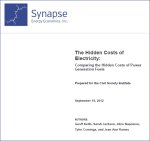A new analysis examines six fuels used to generate electricity and their impacts in relation to water, climate change, air pollution, cost risks and other factors.
The 91 page report was prepared by Synapse Energy Economics for the USA’s Civil Society Institute (CSI) and the Environmental Working Group (EWG).
The paper highlights the fact the U.S. government and energy industries are “literally flying blind as they plan for continued reliance on coal, natural gas, nuclear power and industrial biomass to meet our energy needs,” says Grant Smith, senior energy analyst at the Civil Society Institute.
While focused on the USA, the report has relevant information for Australia.
Water is an important topic discussed – and as we’ve reported before, fossil fuel and nuclear power are real water guzzlers compared to solar panels and wind turbines; even when manufacturing is taken into consideration.
A common furphy bandied about in relation to solar panels is the carbon dioxide impact associated with creating the materials used and manufacturing the modules. The report states the life-cycle greenhouse gases associated with silicon solar panels to be between 26 grams and 183 grams of CO2 equivalent per kilowatt hour, with an average of just 52 grams. For wind power, it’s even less – just 45g per kilowatt hour.
By comparison, coal sits at an average of 790 grams per kilowatt hour – and that’s for the new supercritical generation units. The old clunkers such as Hazelwood power station in Australia would be far higher.
Even the burning of natural gas is a major greenhouse gas offender at 350 – 400 grams of carbon dioxide equivalent per kilowatt hour.
The report also points out coal fired plants in the U.S. are that nation’s largest source of atmospheric sulphur dioxide, mercury, arsenic and acid gases.
Gas fired electricity generation sees significant amounts of nitrogen oxide and particulate matter, plus smaller amounts of carbon monoxide, volatile organic compounds and toxic gases being pumped into the atmosphere. Additionally, there emissions associated with drilling as gas escapes, processing and pipeline operations.
Wind and solar related generation of non-CO2 emissions (associated with manufacturing stages) are quite low on a grams per kilowatt hour basis over the life-cycle of these technologies.
“Too often left out of the equation are a number of important ‘hidden’ costs, also called ‘indirect’ or ‘externalized’ costs, associated with each generation technology,” says Synapse Energy Economics’ Geoff Keith .
“These include costs to society such as depletion of water and other resources, air and water pollution, detrimental impacts on human health and the environment, and contributions to global climate change.”
The report, The Hidden Costs of Electricity: Comparing the Hidden Costs of Power Generation Fuels, can be viewed in full here (PDF).












































